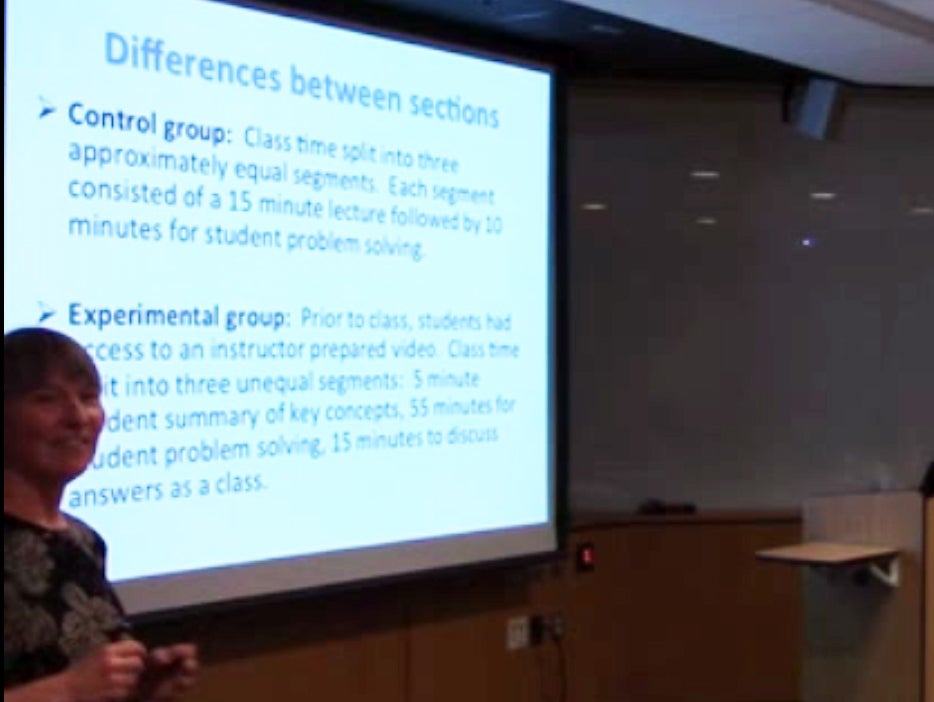 On Friday, December 11th, CSIE|UM welcomed Professor Joanne Smieja from Gonzaga University for a discussion on the effects of “flipped” instruction vs. traditional “unflipped” instruction on students’ performance in the first semester General Chemistry course. Professor Smieja created two general chemistry sections in the Fall of 2014, one taught using the traditional lecture instruction and one taught using a “flipped” style instruction. In the “traditional” section, Professor Smieja lectures for 75% of the class time with the remaining class time used for student activities, while in the “flipped” section, the students were given access to her prepared video lectures prior to class and 100% of the class time was devoted to student activities. In both sections, the students were given the same daily reading assigned from the textbook, the same online homework, and identical midterm and final exams. During the semester Professor Smieja collected data to determine if the class structure affected her students performance in the class. Her talk, entitled “Traditional versus inverted delivery of general chemistry content: Does it make a difference?” discussed her results from this study.
On Friday, December 11th, CSIE|UM welcomed Professor Joanne Smieja from Gonzaga University for a discussion on the effects of “flipped” instruction vs. traditional “unflipped” instruction on students’ performance in the first semester General Chemistry course. Professor Smieja created two general chemistry sections in the Fall of 2014, one taught using the traditional lecture instruction and one taught using a “flipped” style instruction. In the “traditional” section, Professor Smieja lectures for 75% of the class time with the remaining class time used for student activities, while in the “flipped” section, the students were given access to her prepared video lectures prior to class and 100% of the class time was devoted to student activities. In both sections, the students were given the same daily reading assigned from the textbook, the same online homework, and identical midterm and final exams. During the semester Professor Smieja collected data to determine if the class structure affected her students performance in the class. Her talk, entitled “Traditional versus inverted delivery of general chemistry content: Does it make a difference?” discussed her results from this study.
Professor Smieja started her seminar going over her experimental design for the study. She had two sections of 35 students that met twice a week for 75 minutes each in the first semester General Chemistry course. Both sections received the same reading assignments, online pre- and post-class homework, semester quizzes and exams, and a comprehensive final. They also had access to previous year’s quizzes, the suggested textbook problems, online review problems, professor’s office hours and Gonzaga’s tutorial center. The control group received the “traditional” instruction that consisted of 45 minutes of lecture and 30 minutes of student problem solving in class, while the experimental group that received the “flipped” instruction were required to prepare for class by watching instructor prepared videos outside of the class period. During the class period, the “flipped” instruction consisted of a five-minute summary of key concepts, 55 minutes of problem solving, and 10 minutes of discussion of answers. During the course of the semester, Professor Smieja evaluated the effects the instructional approach had on student retention and learning, the students’ approach to learning, the students’ perception of the course, and the students’ attitude toward chemistry.
Professor Smieja found that there were no significant differences between the control and experimental section in terms of student retention and learning with respect to their final grade. But when she took a deeper look into the students’ online homework grades and exam grades she discovered that while both sections had identical exam averages, the control group more students attempted the online homework and scored higher on them than the experimental group. Also, while both sections had similar scores on the knowledge, comprehension, and algorithmic-based questions on the exams, the experimental group scored higher on the conceptual based questions. She also found that the students’ approach to learning in each section were very similar except for two main strategies. The students in the control group viewed reading textbook and working with others outside of class as the most useful activities, while the students in the experimental group viewed watching the instructional videos and working with other inside of class as the most useful. So while the students’ actual performances in the course were not-significantly different, their approaches to their learning were.
Professor Smieja later went on to discuss the effects of the instructional approach on her students’ emotional perception of the course and their attitude toward chemistry. This is where she discovered the most significant differences between the two sections. Based on the Gonzaga’s end of the term online survey her experimental section viewed the course more valuable to their education than the control group. They also found the course more emotionally accessible by the end of the term and had a more positive view of chemistry than her control group.
Professor Smieja used the remainder of her seminar to compare her study to three recently published studies, which showed similar results. She also emphasized that while creating a “flipped” classroom has its difficulties, it is very advantageous for first semester general science courses, such as general chemistry, that have groups of students with very diverse educational backgrounds.

